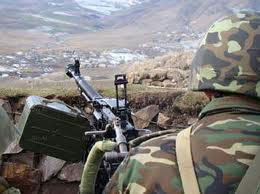
Armenian armed forces have broken the ceasefire with Azerbaijan 101 times in numerous positions by using heavy machine guns and mortars in numerous positions in the last 24 hours, the Azerbaijani defense ministry said Aug. 5.
Armenian armed forces located in the nameless heights and the villages of Berkaber of Armenia’s Ijevan district, Shavarshavan, Barekamavan of Noyemberyan district opened fire at the positions of Azerbaijani armed forces located in the nameless heights and the villages of Qizilhajili, Farakhli, Qaymaqli of the Gazakh district.
Armenian armed forces located in the village of Chinari of Armenia’s Berd district opened fire at the positions of Azerbaijani armed forces located in the village of Kohanebi of the Tovuz district.
Another ceasefire violation came from the positions located near the villages of Tapqaraqoyunlu of the Goranboy district, Chileburt, Chayli, Qizil Oba, Goyarkh of the Terter district, Novruzlu, Shuraabad, Sarijali, Javahirli, Yusifjanli, Kengerli, Shikhlar, Qaraqashli of the Aghdam district, Kuropatkino of the Khojavend district, Garakhanbeyli, Horadiz, Ashagi Seyidahmadli of the Fizuli district and Mehdili of the Jabrayil district.
Moreover, Azerbaijani positions took fire from the positions located on the nameless heights of the Goranboy, Khojavend, Fizuli and Goygol districts.
The opposing side was silenced with return fire.
The conflict between the two South Caucasus countries began in 1988 when Armenia made territorial claims against Azerbaijan. As a result of the ensuing war, in 1992 Armenian armed forces occupied 20 percent of Azerbaijan, including the Nagorno-Karabakh region and seven surrounding districts.
The two countries signed a ceasefire agreement in 1994. The co-chairs of the OSCE Minsk Group, Russia, France and the US are currently holding peace negotiations. Armenia has not yet implemented the UN Security Council’s four resolutions on the liberation of the Nagorno-Karabakh and the surrounding regions.
Trend
